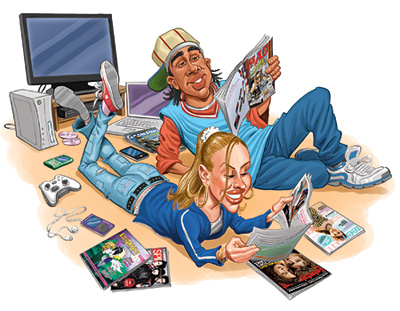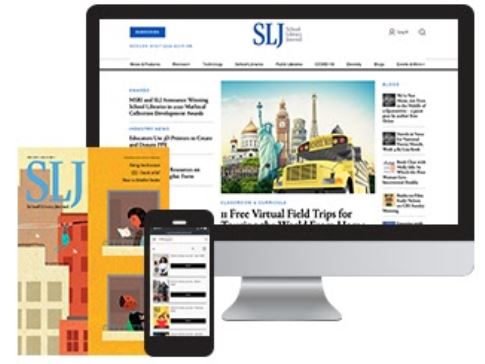The Original Handhelds: Magazines That Teens Can't Resist
Forget about iPods. Here are 11 magazines that teens can’t resist.

Illustration by Tom Richmond
In a world of instant messages, Twitter, and Facebook, what do magazines have to offer teens? Well, as it turns out, plenty. For starters, they feature celebrity gossip, humor, beauty tips, sports, and even manga. Some magazines, including Entertainment Weekly, offer online content that can only be accessed by using a special code that’s available in the print edition. Other magazines tease their Web visitors by displaying the cover of the latest print issue and offering different content online or real-time (and accurate!) news and, uh-huh, more gossip. But as every YA librarian knows, there’s still a place for print in most kids’ hearts.
That’s probably because print publications offer a level of in-person, tactile interaction that online-only magazines can’t match. Plus, print editions can be passed around in a library and discussed in a moderated setting, or marked up to the owner’s liking. Recently, many magazines, like Elle Girl, have moved all their content online, leading some to wonder if the print version will soon be dead. Though the number of glossy periodicals is on the downswing and the future of magazine publishing remains to be seen, there are many publications that still sell well. Here are 11 print magazines that teens (and the librarians who serve them) can’t live without. Entertainment Weekly. When it comes to celebrities or pop culture, anything is fair game for Entertainment Weekly (EW). So it’s no surprise that A-list actors, musicians, and writers (including YA authors) have often graced its cover. EW is also a valuable tool for collection development because it assigns a letter grade to the latest books, tunes, TV shows, and movies and keeps track of best-selling DVDs, singles, and albums. The weekly is also known for its quality photography and writing, which includes a mix of serious and humorous articles and a legion of contributors that reads like a Who’s Who list. Don’t miss EW’s informative and often sardonic Popwatch blog. Published weekly. Audience: middle, junior, and high school. GamePro. Every teen librarian knows that gaming is a great new way to attract kids. The question is, which games should you buy? What if you’re the lone library with an Xbox 360 in a system full of Wiis? GamePro offers reviews of games for all types of game consoles, as well as for PCs. If you’re a nongamer, you need this magazine just as much or more as your gamer colleagues. Reviews are easy to skim through, and its calendars are useful when planning your games budget. Read more reviews, news, and blogs online. Published monthly. Audience: junior and senior high. J-14. Shiny and colorful, J-14 is to generations Y and Z what Tiger Beat was to baby boomers. Its covers are collages of the hottest teen and tween celebrities, promising exclusive interviews and pictures. Instead of highlighting celebrity weddings, pregnancies, and “it” handbags like People and US Weekly, J-14 focuses on teen stars like the Jonas Brothers and Demi Lovato and topics that tween girls can easily relate to, like advice on hair, makeup, school, and friends. Although J-14 may be visually dizzying for those of us over 20, it’s thrilling for teens whose favorite celebs change by the hour. Printed monthly. Audience: middle school and junior high. MAD. This classic satire magazine is still incredibly popular more than 50 years after its debut. On the cover, MAD’s gap-toothed mascot, Alfred E. Neuman, has lampooned everyone from Barack Obama to Bart Simpson. Inside, readers will find spoofs of their favorite pop-culture magazine features (the “Two-Question Interview”), comics that make fun of celebrity trends and popular movies, and features like “Unheroic Watchmen Outtakes.” With its colorful comic-book layout, MAD looks like it’s intended for younger readers, but its humor is much more appealing to older readers who can appreciate comedy along the lines of The Daily Show with Jon Stewart or Family Guy. Published quarterly. Audience: junior high and high school. Shonen Jump and Shojo Beat. It seems like teens are clamoring for a different hot manga series every day. How do they keep all the characters and story lines straight? Part of their secret may be Shonen Jump, a magazine that offers previews of the hottest manga series, plus interviews with the real-life artists behind those heroes. Shonen Jump covers shonen, boys’ manga, and its sister publication, Shojo Beat, runs previews of shojo, girls’ manga. For fans of Japanese pop culture and fashion, Shojo Beat also features glossy, full-color photo spreads and interviews with popular manga authors and artists. Manga previews are printed in black and white on newsprint. Published weekly. Audience: middle, junior, and high school. Spin. If you’re an American Idol addict or a Top 40 junkie, you’ll have to look elsewhere for your magazine fix. Spin focuses almost exclusively on alternative, indie, and punk music. But librarians looking to expand their pop music collection will find Spin indispensable because it highlights bands like Vampire Weekend and the Yeah Yeah Yeahs, which sell well on sites like iTunes and eMusic but don’t get much mainstream radio play. Spin also offers interviews, full-color photographs, industry news, and album reviews. There’s a lot more to see online, plus you can sign up for its weekly newsletter, “SPINsider,” offering everything from industry news to music blogs and videos. Published monthly. Audience: high school. Sports Illustrated. If you only have space for one sports magazine, this should be it. Sports Illustrated (SI) covers high school, college, amateur, and professional sports, including football, baseball, basketball, tennis, golf, and more. It’s also known for its iconic photography, like the cover portrait of swimmer Michael Phelps with all eight of his Olympic gold medals hanging from his neck. SI’s online content is vast and diverse, including real-time sports scores and a beta feature called the SI Vault, an archive that includes some of the most popular covers and articles. Copies guaranteed to be stolen include the annual Super Bowl supplement and the infamous swimsuit issue—but, then, you already knew that. Published weekly. Audience: middle, junior, and high school. Teen Ink. Printed to look like a small traditional newspaper, Teen Ink (TI) is the premier for-teens, by-teens print publication. Now in its 20th year, TI features poetry, essays, photos, reviews, and opinion pieces, and it also recognizes outstanding teachers. In addition to its monthly edition, TI publishes special stand-alone collections, such as Love and Relationships and Written in the Dirt. Unlike some other teen publications, TI never charges budding poets and writers and doesn’t push them into buying expensive volumes in order to see their names in print. Printed monthly. Audience: middle, junior, and high school. Teen Vogue. For fashion-conscious girls too old for J-14 but too young for W, stylish Teen Vogue may be the answer. With its focus on higher-end cosmetics and designers like Rock & Republic, it’s what a young Blair and Serena of the “Gossip Girls” series might have read. Don’t disregard the Upper East Side fashion focus if you’re in a small rural or suburban community, though; Teen Vogue may provide inspiration to ambitious fashion DIYers and trend hunters. The covers usually feature older teen or young adult celebrities known for their style, like Emma Roberts, Emma Watson, and Blake Lively. Published monthly. Audience: junior high and high school. Transworld Skateboarding. Skateboarding isn’t an activity to be left on the sidewalk. It’s a sport, an art, and a world with a fashion sense all its own. You’ll see more shoe ads in Transworld Skateboarding (TS) than you’ll see in Teen Vogue. TS features interviews with skateboarding professionals, detailed (and often bloody) photos of both graceful and klutzy moments in skateboarding, news, video game reviews, and stunning action photography. The magazine has also produced a series of skateboarding videos, including Sight Unseen and The Reason. Published monthly, plus two special issues. Audience: junior high and high school.
J-14. Shiny and colorful, J-14 is to generations Y and Z what Tiger Beat was to baby boomers. Its covers are collages of the hottest teen and tween celebrities, promising exclusive interviews and pictures. Instead of highlighting celebrity weddings, pregnancies, and “it” handbags like People and US Weekly, J-14 focuses on teen stars like the Jonas Brothers and Demi Lovato and topics that tween girls can easily relate to, like advice on hair, makeup, school, and friends. Although J-14 may be visually dizzying for those of us over 20, it’s thrilling for teens whose favorite celebs change by the hour. Printed monthly. Audience: middle school and junior high. MAD. This classic satire magazine is still incredibly popular more than 50 years after its debut. On the cover, MAD’s gap-toothed mascot, Alfred E. Neuman, has lampooned everyone from Barack Obama to Bart Simpson. Inside, readers will find spoofs of their favorite pop-culture magazine features (the “Two-Question Interview”), comics that make fun of celebrity trends and popular movies, and features like “Unheroic Watchmen Outtakes.” With its colorful comic-book layout, MAD looks like it’s intended for younger readers, but its humor is much more appealing to older readers who can appreciate comedy along the lines of The Daily Show with Jon Stewart or Family Guy. Published quarterly. Audience: junior high and high school. Shonen Jump and Shojo Beat. It seems like teens are clamoring for a different hot manga series every day. How do they keep all the characters and story lines straight? Part of their secret may be Shonen Jump, a magazine that offers previews of the hottest manga series, plus interviews with the real-life artists behind those heroes. Shonen Jump covers shonen, boys’ manga, and its sister publication, Shojo Beat, runs previews of shojo, girls’ manga. For fans of Japanese pop culture and fashion, Shojo Beat also features glossy, full-color photo spreads and interviews with popular manga authors and artists. Manga previews are printed in black and white on newsprint. Published weekly. Audience: middle, junior, and high school. Spin. If you’re an American Idol addict or a Top 40 junkie, you’ll have to look elsewhere for your magazine fix. Spin focuses almost exclusively on alternative, indie, and punk music. But librarians looking to expand their pop music collection will find Spin indispensable because it highlights bands like Vampire Weekend and the Yeah Yeah Yeahs, which sell well on sites like iTunes and eMusic but don’t get much mainstream radio play. Spin also offers interviews, full-color photographs, industry news, and album reviews. There’s a lot more to see online, plus you can sign up for its weekly newsletter, “SPINsider,” offering everything from industry news to music blogs and videos. Published monthly. Audience: high school. Sports Illustrated. If you only have space for one sports magazine, this should be it. Sports Illustrated (SI) covers high school, college, amateur, and professional sports, including football, baseball, basketball, tennis, golf, and more. It’s also known for its iconic photography, like the cover portrait of swimmer Michael Phelps with all eight of his Olympic gold medals hanging from his neck. SI’s online content is vast and diverse, including real-time sports scores and a beta feature called the SI Vault, an archive that includes some of the most popular covers and articles. Copies guaranteed to be stolen include the annual Super Bowl supplement and the infamous swimsuit issue—but, then, you already knew that. Published weekly. Audience: middle, junior, and high school. Teen Ink. Printed to look like a small traditional newspaper, Teen Ink (TI) is the premier for-teens, by-teens print publication. Now in its 20th year, TI features poetry, essays, photos, reviews, and opinion pieces, and it also recognizes outstanding teachers. In addition to its monthly edition, TI publishes special stand-alone collections, such as Love and Relationships and Written in the Dirt. Unlike some other teen publications, TI never charges budding poets and writers and doesn’t push them into buying expensive volumes in order to see their names in print. Printed monthly. Audience: middle, junior, and high school. Teen Vogue. For fashion-conscious girls too old for J-14 but too young for W, stylish Teen Vogue may be the answer. With its focus on higher-end cosmetics and designers like Rock & Republic, it’s what a young Blair and Serena of the “Gossip Girls” series might have read. Don’t disregard the Upper East Side fashion focus if you’re in a small rural or suburban community, though; Teen Vogue may provide inspiration to ambitious fashion DIYers and trend hunters. The covers usually feature older teen or young adult celebrities known for their style, like Emma Roberts, Emma Watson, and Blake Lively. Published monthly. Audience: junior high and high school. Transworld Skateboarding. Skateboarding isn’t an activity to be left on the sidewalk. It’s a sport, an art, and a world with a fashion sense all its own. You’ll see more shoe ads in Transworld Skateboarding (TS) than you’ll see in Teen Vogue. TS features interviews with skateboarding professionals, detailed (and often bloody) photos of both graceful and klutzy moments in skateboarding, news, video game reviews, and stunning action photography. The magazine has also produced a series of skateboarding videos, including Sight Unseen and The Reason. Published monthly, plus two special issues. Audience: junior high and high school. As a teen, Carlie Webber (carliebeth@gmail.com), now the young adult services librarian for the Bergen County Cooperative Library System in Hackensack, NJ, learned everything she needed to know from reading Sassy magazine.
RELATED
The job outlook in 2030: Librarians will be in demand
The job outlook in 2030: Librarians will be in demand
ALREADY A SUBSCRIBER? LOG IN
We are currently offering this content for free. Sign up now to activate your personal profile, where you can save articles for future viewing






Add Comment :-
Be the first reader to comment.
Comment Policy:
Comment should not be empty !!!